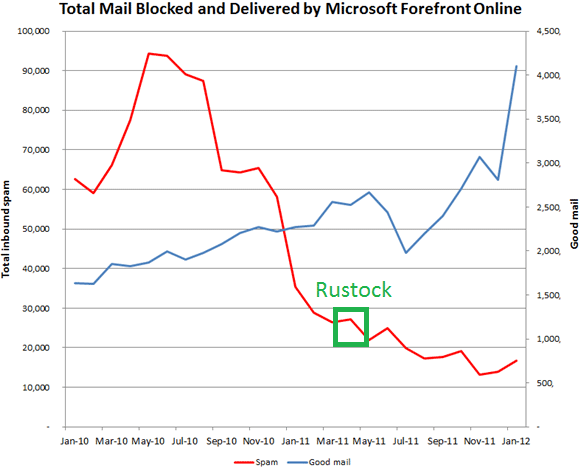


|
||
|
||
Arstechnica wrote an article recently entitled Spam levels still low a year after Rustock botnet takedown. From the article:
In March 2011, a Microsoft-led team targeted and decapitated the Rustock botnet, and a dramatic decrease in spam traffic was noticed almost immediately. It turns out that a full year later, spammers have not been able to fill the gaping hole left by Rustock’s absence.
Just before the Rustock takedown, “spam levels were around the 150 billion mark daily,” security vendor Commtouch said in a new analysis. “Spam levels dropped immediately after that takedown and have continued to decrease ever since. In the first quarter of 2012, an average of 94 billion spam emails were sent per day… There is no sign of a return to pre-Rustock spam levels.”
Rustock was responsible for sending 30 billion spam e-mails a day, and thus its takedown alone can’t account for the entire drop in spam volume. Commtouch said the sustained improvement was a combination of multiple botnet takedowns, as well as “increased prosecution of spammers and the source industries such as fake pharmaceuticals and replicas.”
The article is more detailed that numerous things have contributed to the decline in spam since then. However, the article misrepresents Rustock’s effect on the spam levels. It’s completely true that Rustock was the largest botnet and sent the most spam (by total individual spam connections). However, spam was falling even before that:

You can see starting in May 2010, spam hit a peak and has been declining ever since. Taking out Rustock no doubt accelerated that but that alone was not responsible for the decline in spam.
Commtouch’s report warns that abuse is still with us: botnets are growing and spammers are finding new ways to infect computers. The problem has not gone away.
So what’s going on?
That is what accounts for the decline in spam since the Rustock takedown, and it’s corresponding lack of re-emergence since then.
Sponsored byVerisign

Sponsored byCSC

Sponsored byIPv4.Global

Sponsored byWhoisXML API

Sponsored byVerisign

Sponsored byDNIB.com

Sponsored byRadix
